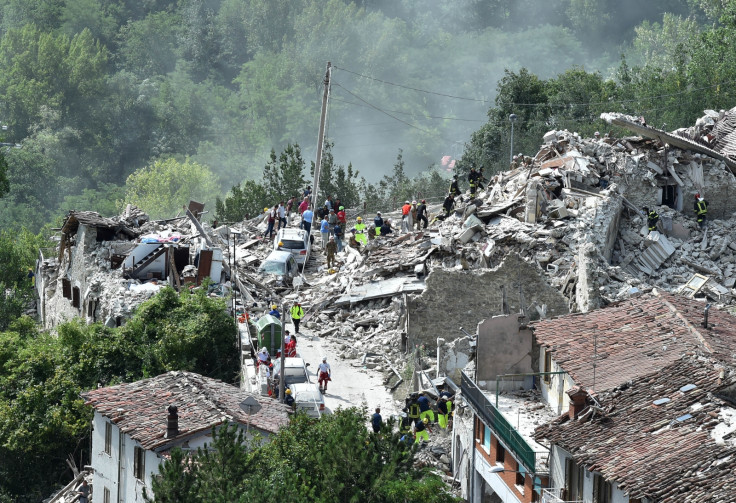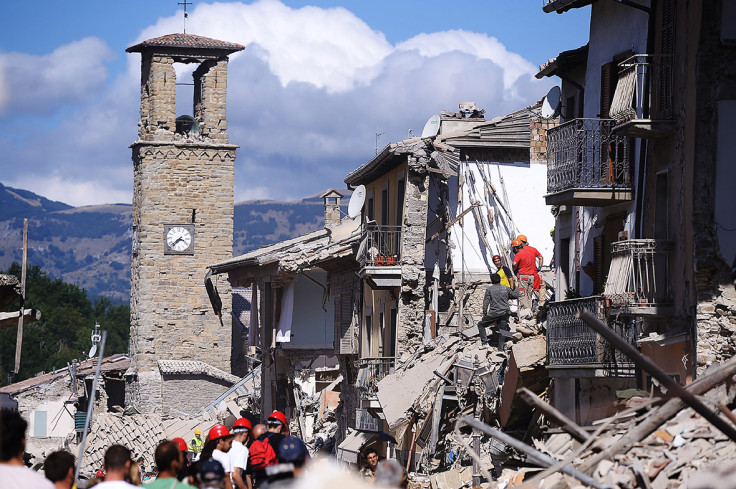Italy earthquake: What is a 6.2-magnitude quake and what are aftershocks?
Earthquake in central Italy leaves at least 37 people dead and more remain trapped under rubble.
A devastating magnitude-6.2 earthquake hit central Italy in the early hours of Wednesday (24 August 2016), leaving at least 37 people dead and many more injured or trapped under rubble. The quake struck at 03:36 local time around 60 miles north-east of Rome.
Some of the worst-affected areas include the central-Italian towns of Amatrice and Accumoli – the latter is thought to be closest to the epicentre.
The quake itself was followed by a series of powerful aftershocks. Tremors were felt all the way up to Rome, with the capital's buildings reportedly shaking for around 20 seconds.
IBTimes UK answers some of the questions you may now be asking.
What does a 6.2 magnitude mean?
The magnitude of an earthquake is a quantitative measure of the size of the earthquake and its seismic waves – the waves of energy caused by the sudden breaking of rock within the Earth.
Different scales to measure magnitude exist, but here the 6.2 magnitude refers to a measurement on the Richter scale. It is an estimation based on the logarithm of the amplitude of waves recorded by seismographs. Adjustments are then made for the variation in the distance between the various seismographs and the epicentre of the earthquake.
The Richter scale is expressed in decimal numbers – from 2.5 or less, to 8.0 or greater. An earthquake with a magnitude of between 6.1 and 6.9, as with the one in Italy, can cause a lot of damage in populated areas. Up to 100 earthquakes of this magnitude range can occur annually. In contrast, up to 900 000 'mini earthquakes', ie below a 2.5 magnitude, happen each year and are not usually felt.
In comparison, the 2015 Nepal earthquake, which killed more than 8000 people, was a magnitude-7.8 quake. The last deadliest earthquake in Italy also occurred in the centre of the country, near L'Aquila, in 2009, and was a magnitude-6.3 quake in which 308 people are known to have died.
Magnitude is not the same thing as intensity, which looks at the severity of earthquake shaking using another, more descriptive scale – the Modified Mecalli Intensity Scale.

What are aftershocks and why can they be dangerous?
Witnesses of the earthquake in Italy have reported a series of several potent aftershocks. A large earthquake usually does not come on its own: powerful tremors can be felt before and after the main shock. The main earthquake, with the largest magnitude is called 'mainshock'. It is sometimes preceded by foreshocks and almost always by aftershocks.
Aftershocks occur in rocks located near the epicentre or along the fault from which the main quake originated. When an earthquake first occurs, the fracturing rocks release energy, which is often transferred to nearby rocks. This leads to a buildup of stress within and between these rocks. Eventually the rocks fracture under this strain, leading to a series of smaller tremors.
Aftershocks are generally less powerful than the mainshock, and they decrease in magnitude and frequency over time. But they can still be significant, and are often underestimated by rescue workers and local populations. Aftershocks can be dangerous and cause further damage and more casualties; they often hamper rescue efforts by further destabilising buildings and causing greater stress for the people affected.
"Aftershocks are particularly dangerous, as even small tremors can make building collapse if they have been badly damaged during the main quake. Some new buildings are erected with earthquakes in mind, but it is likely that many of the older buildings in these Italian towns may be toppled by minor shocks, causing further destruction and increasing the risks for people", Dr Roger Musson, from the British Geological Survey, told IBTimes UK.
"Earthquakes don't kill people, buildings do. However much we research earthquake forecasting the front line of defence is to get the buildings right. We know how to do this, and there is a lot of good practice in Italy in earthquake engineering. Nevertheless there is a large legacy of mainly historical masonry buildings that remain vulnerable", Ian Main, Professor of Seismology & Rock Physics at the University of Edinburgh, added.

Is this central region of Italy particularly prone to earthquakes?
L'Aquila, not far from where the deadly earthquake in 2009 is only around 30 miles away from Amatrice, highlighting that large quakes are not uncommon in this central region of Italy.
The country as a whole has a long history of destructive earthquakes and its central regions have always been viewed as the more likely to suffer from earthquakes.
One of the main reasons for this is that the country is located at the meeting point of the Eurasian Plate and the African Plate, leading to considerable seismic and volcanic activity. This is particularly the case at the transition zone between the Southern and Central Apennines – the belt of mountains that runs down through central Italy. This means that towns that lie close by, like L'Aquila or the villages affected by the recent quake, are particularly vulnerable to quakes.
Why were the tremors felt up to Rome?
When an earthquake occurs, seismic waves immediately begin racing outward in all directions, losing energy as they spread out. If they encounter no interference, primary and secondary waves for a large earthquake can quickly travel all of the way through the middle of the Earth and faintly arrive on the opposite side of the globe.
The speed of waves depends on the density and elasticity of the medium, but typically secondary waves have a velocity ranging 2-8km/s – quickly reaching towns a few kilometres away from the epicentre without being to weakened yet.
"The quake has even been felt as far as Austria and Slovenia. A good analogy is that of throwing a stone in water. It makes a splash, and the waves spread out quickly, but as they do, they gradually get weaker. They might reach distant location, but with less strength", Musson explained.
"People who are standing on top of high buildings may also have felt the shocks even more, as being high up amplifies the shake, especially if you are lying down, with your body in the contact with the ground".
In a powerful earthquake like the one in Italy, the waves would have thus travelled fast to Rome – which is just over 80 miles away from Amatrice – still with an important amount of energy, so residents may have felt them.
© Copyright IBTimes 2025. All rights reserved.






















